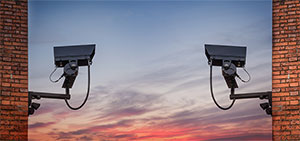When it comes to crime, size doesn’t matter. Criminals seek opportunity, and that is just as likely to present itself at a small to mid-size retail or commercial enterprise as it is with a larger one. However, small businesses can be especially vulnerable because they don’t typically have the resources to guard against crime.
Research from the U.S. Small Business Administration (SBA) found that less than half (48 percent) of approximately 400 small businesses surveyed had no security measures in place, nor did they report some crimes, such as employee theft. Crime is not an inexpensive proposition for a small business. On average, burglaries cost businesses nearly $2,000, while shoplifting weighs in at more than $20 per incident.
The headlines are filled with tales of smaller businesses that have fallen victim to opportunistic criminals. During a theft spree in two states, for example, thieves targeted car dealerships, stealing wheels and rims. Although it’s not known what type of security systems, if any, were in place at these establishments, this example shows just how vulnerable smaller businesses can be. And, this came at a steep price as well: This crime wave was estimated to be in the hundreds of thousands of dollars.
 In response, businesses, such as these car lots, will often look to install a combination of video, intruder alarm and maybe even access control systems that can provide them with the ability to react in real time or at least respond after the fact with video that the police can use to identify the criminals or help make the case when the thieves are apprehended.
In response, businesses, such as these car lots, will often look to install a combination of video, intruder alarm and maybe even access control systems that can provide them with the ability to react in real time or at least respond after the fact with video that the police can use to identify the criminals or help make the case when the thieves are apprehended.
The drawback, however, has been that small businesses often don’t have a dedicated individual on staff to monitor video, respond to alarms and stay on top of the latest developments with the system, let alone be responsible for training others.
And, when a business does invest in security — installing a few analog cameras aimed at the lot filled with new cars, alarming the doors or putting in an access control system so employees can swipe a card to enter the building — the systems often aren’t integrated. Should there be a problem, someone would likely have to manually view the video then access the card-based system data or the alarm information separately, comparing the time stamp to see where it all fits together.
Another problem has been that all of this information is often stored on a PC that is vulnerable to viruses and hacking and can often be accessed by any of the employees.
So, what alternatives do small to medium business operators have?
One option is to invest in the same enterprise-level security solution that larger businesses have adopted; but, this is usually overkill for small enterprises. These organizations aren’t managing hundreds of cameras or arming thousands of doors or granting access privileges to an army of workers. So the investment could be out of line with current or even future needs. Besides, this doesn’t address the need for a solution that can be handled easily by those tasked with other responsibilities as well.
In listening to the needs of small and mid-size businesses, technology platforms exist that address the key concerns: ease of use, minimal training and the ability of the security system to grow and evolve with the business.
Looking again at the car dealership model, the main requirements are a way to monitor the premises, respond to alarms as they happen or after the fact and provide access to employees — ideally all from a single platform.
With one platform for the control of video, intrusion and access control, there is just one system to learn and one main apparatus to deal with that isn’t a PC, but rather a dedicated appliance for security. Although bringing together three diverse systems, the individual or individuals responsible can customize a dashboard so they can move among the different software applications easily, viewing cameras or recorded video or locking and unlocking doors or requesting reports as needed. And, because the software is accessible via a phone or tablet-based app, these individuals don’t need to be on-site to perform these tasks.
While initial training is needed to get a true understanding of how such an integrated system works, the focus in developing these new products for small to mid-size businesses has been on keeping training minimal and operations simple.
A business, such as the car dealership, need not invest in all levels of security to reap the benefits of this type of system. Initially, the user may want to focus on building a video surveillance solution, but with this integrated product he knows he can also move into access control or intrusion alarms when the time is right.
The need for security among all levels of businesses is growing, and now there are solutions on the market that can allow these enterprises to build an integrated system that is just right for them.